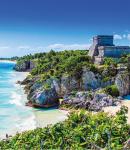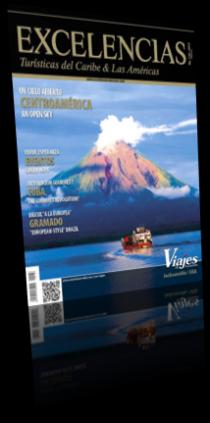- On the Traces of the Mayans.
Traveling throughout the Mexican southern region, with plenty of history and heritage, surrounded by nature and built with rocks, is not only a dream, but it can be a reality
When I arrived in Tuxtla Gutierrez, the capital of Chiapas State, I wasn’t sure about which way to go. I was interested in touring the southern region of Mexico, but it’s quite difficult; there are just a few regions in the world that, within a few miles, feature natural attractions, areas that speak volumes about the pre-Hispanic past, colonial life, delicious food and beaches. It’s impossible to see it all. Not even in a lifetime. That night I walked into a restaurant where they serve a drink called Pumpo, prepared with pineapple juice, vodka and ice in a hollow pumpkin. Before serving, it the waiter shouts: "Pumpo coming up!... There goes the pumpo!... Here’s the pumpo!"; another waiter rings a bell and the rest applauds and makes a racket. So I made up my mind: I’d go to the Drain Canyon and the Palenque archaeological site.
From the view towers, the Canyon makes you be thankful for having eyes to look at those limestone walls that go up to a thousand meters, the blue and green bottom of Grijalva River and the lush foliage that houses crocodiles, herons, turkey buzzards and a world of wildlife species. Before heading to Palenque I visited San Cristobal de las Casas. It still features cobblestoned streets, Baroque-style churches and houses with red-tiled gables and flower sills in the backyards.
In the heart of Lacandona jungle, on my way to the Mayan city, I found Blue Water falls, the result of the flow of Tulijá river down to a terrace bank with ponds. Palenque makes everybody drop their jaws, specially the Temple of Inscriptions, packed with hieroglyphs that tell the story of the Mayan civilization. People say that the ruins we see are only one percent of the city: the rest is buried. And it’s true: you can see remains under the tree roots. It was in Palenque where I decided how to make this journey. I’d followed a Mayan route through the ancient cities built by this culture. I was sure that I would find some colonial cities on my way, beaches and the picture-perfect nature. That’s exactly what happened.
I went to Campeche. A few years ago I’d visited Calakmul, another Mayan city in the middle of the jungle. I saw funeral crypts and carved steles within its pyramid. That helped me stay on track and I headed to Edzna, another archaeological site. Campeche city was right on my way with its forts, strongholds and the remains of the wall that for many years protected it from pirate attacks; and that peaceful seawall where I sat down and watched the sunset and a fish boat that was sailing back home. In Edzna, the inhabitants built an ingenious system of canals, up to six kilometer long, as well as depots where they used to store and distribute the water. Paved streets give access to some of the most important architectural sites.
I went to Merida, the capital, so as to get some sleep. While I was eating some dogfish bread —a sort of sandwich prepared with omelets, fish and dipped in tomato sauce— I had to decide whether to go to Chichen Itza ruins, a henequen ranch, or X'Batún cenote. I walked down colonial Montejo Promenade and its white houses that harken back to the 18th century. I finally decided to go to the natural landscape. I had seen several archaeological sites and Chichen Itza would be the perfect pretext to come back to the Mexico’s southern region.
It was worth it. X'Batún cenote is a natural pond with turquoise water, so crystal-clear that you can see the bottom some 20 meters down. The roots of some trees were carpeted with green lilies. I dived into the water and it was surprisingly warm. The deepest area goes 57 meters down and it’s full of human skulls, vessels and offerings related to Mayan ceremonies.
When I went to Quintana Roo I already knew what I wanted to enjoy in that state: beach and sea. I also knew which ones: Playa del Carmen and Cozumel. Fortunately, Tulum archaeological site is near the area. It was one of the few inhabited Mayan settlements when the Spaniards arrived in; nevertheless, there were no residents there by the end of the 16th century. So I visited the ruins. The beach stretches in front of the Castle, the most emblematic building. I took a rest on the white and fine sand that looks like powder, swam in the quiet waters of the Caribbean Sea and watched a rainbow over the cliff.
With such scenery, the south of Mexico let the door open for me to return as many times as I want.



























































































































